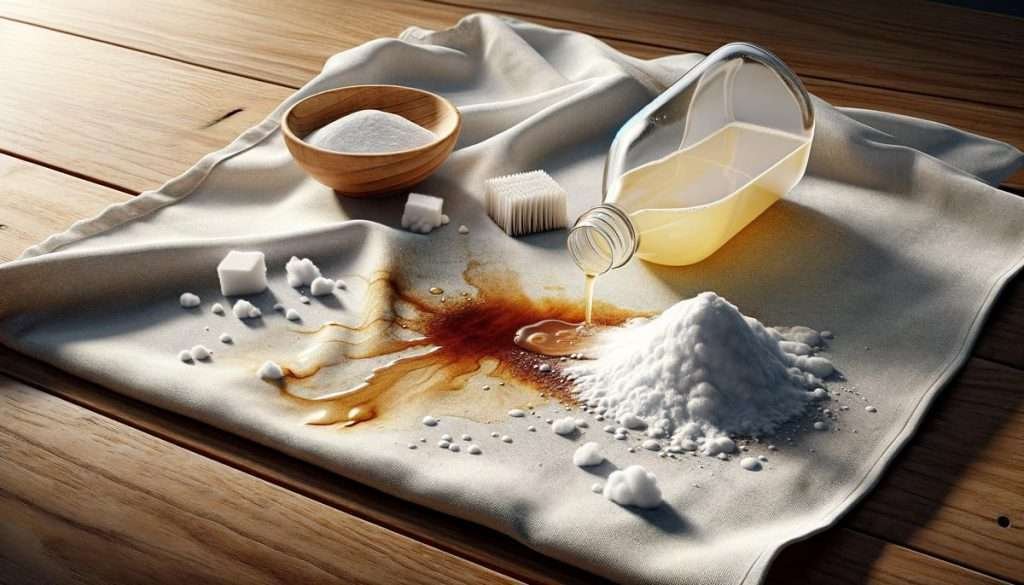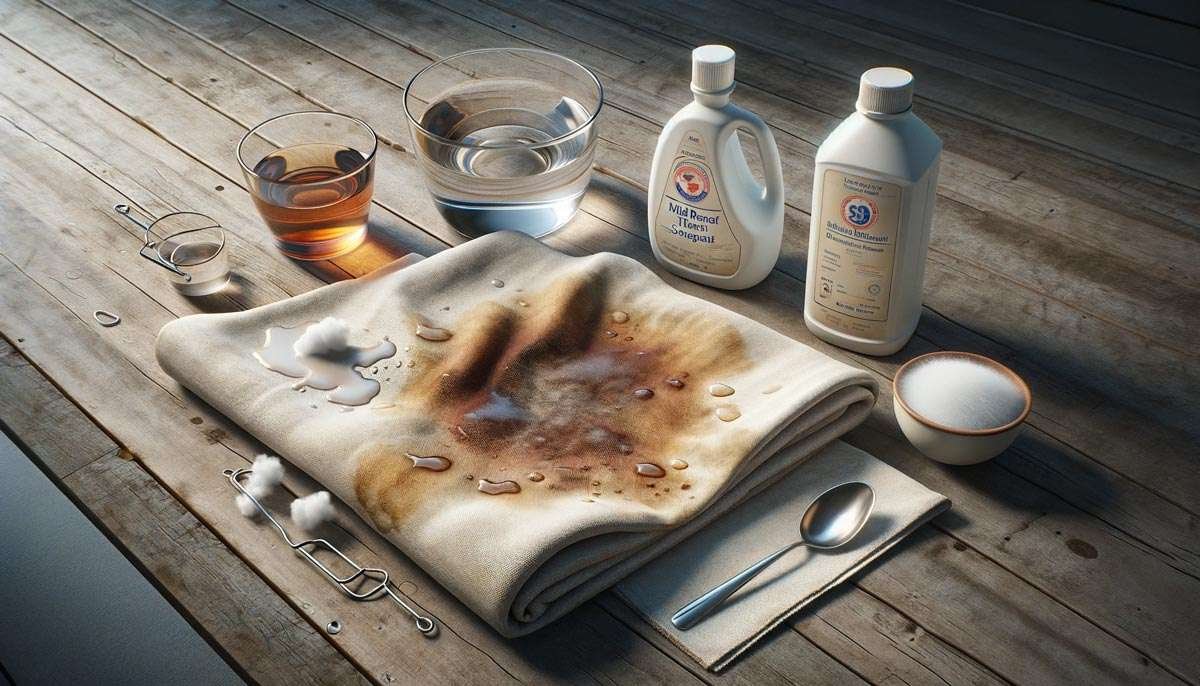People all over the world consume a huge number of cups of tea. Whether you are on a tea break or in a meeting, it has become a part of our life. The expected tea industry revenue is projected to reach US$127.3 billion in 2024. But guess what? Sometimes, tea stains can be a headache.
It’s all because of something called tannins in tea. These tiny things make tea delicious but also turn it into a stain-making superhero. To address these issues, we have prepared a guide for you on how to remove tea stains from fabric step by step.
Whether you love tea or just want to keep your stuff clean, this guide is for you. Let’s dive into the world of tea stains and learn how to make them disappear.
How to Remove Tea Stains from Fabric
Step 1: Gather Your Supplies
To effectively remove tea stains from fabric, it’s essential to have the right tools and materials at hand. Before you start, collect the following items:
- A clean cloth: Preferably white or colorfast to avoid transferring dyes onto the stained fabric.
- Cold water: You’ll need this for rinsing and treating the stain.
- Mild detergent: Choose a gentle, colour-safe detergent, especially for coloured or delicate fabrics.
- White vinegar: This household staple is excellent for stain removal and is safe for most fabrics.
- A spoon: Useful for mixing and measuring solutions.
- A sponge: A soft sponge or cloth is helpful for dabbing and applying stain treatments.
Step 2: Blot the Stain
Blotting is the first crucial step in dealing with a tea stain.
Place a clean cloth or paper towel under the stained area to prevent the stain from spreading to other parts of the fabric.
Gently blot the tea stain with another clean cloth or paper towel. Start from the outer edges of the stain and work your way inward. Avoid rubbing the stain, as this can force it deeper into the fabric fibres.
Continue blotting until you’ve absorbed as much of the tea as possible. Be patient and use a gentle touch to prevent further damage to the fabric.
By following these steps, you’ll effectively remove excess tea from the fabric, making it easier to tackle the remaining stain.
Step 3: Rinse with Cold Water
After blotting, it’s time to rinse out any loose tea particles and minimise the stain’s appearance. Here’s how to do it properly:
Place the fabric under cold, running water, with the stained side facing down. The water should flow through the fabric and push the tea stain out.
Continue rinsing for a few minutes or until you no longer see tea colour washing out of the fabric.
Remember to keep the water temperature cold, as hot water can set the stain.
This step helps remove any remaining loose tea particles and dilutes the stain, making it easier to treat.
Step 4: Apply a Mild Detergent
Now that you’ve blotted and rinsed the tea stain, it’s time to move on to the next step: applying a mild detergent solution. Here’s how to proceed:
Mix a teaspoon of mild detergent with a cup of cold water in a clean container.
Dip a clean cloth or sponge into the detergent solution.
Gently dab the stained area with the cloth or sponge, working from the outside of the stain towards the centre.
Continue to dab the fabric until the tea stain begins to lift. Be patient, as this may take several minutes.
Using a mild detergent helps break down the tea stain’s compounds, making it easier to remove. Avoid using harsh or bleach-containing detergents, especially on coloured fabrics, as they can cause further damage.
Step 5: Rinse Again
After treating the stain with detergent, rinse the fabric thoroughly with cold water. Follow these steps:
Hold the fabric under cold running water with the stained area facing down, similar to the rinsing step in the previous section.
Continue rinsing until the detergent has been completely washed out, and the water runs clear.
Ensure there are no remaining suds on the fabric.
Rinsing helps remove any residual detergent and tea stain remnants. It’s essential to complete this step thoroughly to prevent any chemical residue from remaining on the fabric.
Step 6: Treat with White Vinegar
If the tea stain persists after following the previous steps, white vinegar can be a powerful ally in removing it. Here’s how to use white vinegar effectively:
Mix one part white vinegar with two parts cold water to create a vinegar solution.
Dab the stained area with this solution using a clean cloth or sponge.
Let the vinegar solution sit on the stain for a few minutes, allowing it to break down the remaining tea stain.
White vinegar is particularly effective in tackling tea stains because it helps neutralise and dissolve the tannins responsible for the discoloration.
Step 7: Machine Wash (Optional)
For fabrics that are machine washable, you can finish the stain removal process by laundering the item as usual. However, before placing it in the washing machine, perform a final check for any lingering signs of the tea stain. If the stain is entirely gone, proceed with the following steps:
Place the fabric in the washing machine, following the care label instructions.
Use a gentle cycle with cold water, especially for delicate fabrics.
Add your regular detergent to the washing machine.
Once the cycle is complete, inspect the fabric one last time to ensure the tea stain is gone before air drying or machine drying.
Machine washing helps remove any final traces of the stain and leaves your fabric looking fresh and clean.
Alternative Techniques

Using Baking Soda and Vinegar
If you prefer natural remedies for stain removal, consider using baking soda and vinegar as an alternative approach. Here’s how to do it:
Step 1: Create a Paste
- Mix a small amount of baking soda with water to create a thick paste. Ensure it has a toothpaste-like consistency.
Step 2: Apply the Paste
- Apply the baking soda paste directly onto the tea stain and let it sit for about 15 minutes. This will help absorb and lift the stain from the fabric fibres.
Step 3: Rinse and Treat with Vinegar
- After the paste has had time to work its magic, rinse the fabric with cold water to remove the baking soda.
- Then, treat the area with the white vinegar solution as mentioned earlier. The combination of baking soda and vinegar can be particularly effective in tackling tough stains.
Step 4: Machine Wash (Optional)
- For washable fabrics, you can finish by placing the item in the washing machine. Check for any remaining stains before washing.
For Delicate Fabrics (Wool and Silk)

Tea stains on delicate fabrics like wool and silk require special care:
Step 1: Use Cold Water
- Skip the use of detergent for delicate fabrics and use cold water only. These materials are sensitive to chemicals, and cold water can often do the trick.
Step 2: Consult a Professional Cleaner
- If the tea stain persists on delicate fabrics even after cold water treatment, it’s advisable to consult a professional dry cleaner. They have the expertise and equipment to handle delicate fabrics without causing damage.
Conclusion
Successfully removing tea stains from fabric is achievable with the right knowledge and techniques. Whether you opt for the traditional method with mild detergent and vinegar or experiment with natural remedies like baking soda and vinegar, you now have a comprehensive guide to rely on.
Remember that prompt action is key when dealing with tea stains. By following these steps and considering alternative methods, you can ensure your fabrics remain stain-free and in excellent condition.
Now that you’ve armed yourself with these stain removal techniques, you can confidently tackle tea stains on various fabrics and keep your clothing and textiles looking pristine.

